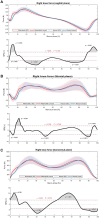Effect of Different Footwear on the Knee Joint: Biomechanical Analysis and Acute T2 Relaxation Time Changes After Walking in Minimalistic and Neutral Footwear
- PMID: 40895637
- PMCID: PMC12397610
- DOI: 10.1177/23259671251346985
Effect of Different Footwear on the Knee Joint: Biomechanical Analysis and Acute T2 Relaxation Time Changes After Walking in Minimalistic and Neutral Footwear
Abstract
Background: Walking in minimalistic footwear (MF) increases mechanical loading on the knee joint, exposing it to acute stresses that may heighten the risk of early onset of knee osteoarthritis. This type of footwear can modify walking patterns in the lower limbs, further intensifying joint stress and contributing to the deterioration of articular surfaces.
Purpose: First, to evaluate the differences in kinetic variables associated with the early onset of knee osteoarthritis between MF and neutral footwear (NF) during walking; second, to determine the extent of acute cartilage loading in the knee joint, particularly footwear after 45 minutes of walking in an urban environment, using magnetic resonance imaging (T2 relaxation times [T2RTs] and percentage change of loading) in weightbearing zones.
Study design: Controlled laboratory study.
Methods: Knee forces and knee moments were obtained during walking trials of 20 healthy participants using statistical parametric mapping. The analysis focused on alterations across specific intervals of the stance phase, expressed as percentages of the gait cycle. T2RT values of cartilage were quantified using a 1.5 T magnetic resonance imaging at baseline and immediately after 45 minutes of walking in each condition.
Results: Significant differences were observed in knee force during the stance phase: (1) in the sagittal plane, greater values were between 2% and 9% and between 90% and 100%, and lower values were between 18% and 40% and between 62% and 85% in MF; (2) the frontal plane showed lower values between 7% and 14% and 98% in MF, and greater values were between 7% and 14% and 98% in MF; and (3) the transversal plane showed greater values between 0% and 9% and between 54% and 78%, and lower values were between 25% and 40% and between 81% and 100% in MF. Knee adduction moment showed significantly lower values between 0% and 8%, 32% and 90%, and >92% and 100%. Knee flexion moment showed significantly lower values between 3% and 5%, 25% and 69%, and >7% and 19% in MF. The main effect of loading in NF of cartilage showed significantly lower T2RT values in all superficial femur parts and significantly greater T2RT values in deep central tibia. MF showed significantly lower T2RT values in the superficial anterior-posterior femur in the medial cartilage compartment.
Conclusion: Increased knee moments in all planes reflect the effect of an acute change to particular footwear. NF reveals a greater response to loading in weightbearing knee cartilage zones. The superficial layers appeared to be more sensitive to loading after 45 minutes of walking.
Keywords: biomechanics; footwear; gait; magnetic resonance imaging; minimalistic; neutral.
© The Author(s) 2025.
Conflict of interest statement
One or more of the authors has declared the following potential conflict of interest or source of funding: This research was supported by the University of Ostrava (grant No.: SGS01/PdF/2020-2021 and SGS08/PDF/22) and by the European Union and Ministry of Education, Youth and Sports of the Czech Republic (grant No.: CZ.02.1.01/0.0/0.0/16_019/0000798 Program 4 Healthy Aging in Industrial Environment). AOSSM checks author disclosures against the Open Payments Database (OPD). AOSSM has not conducted an independent investigation on the OPD and disclaims any liability or responsibility relating thereto. Ethical approval for this study was obtained from University of Ostrava, Pedagogical faculty (OU-53107/45-2022).
Figures



References
-
- Amin S, Luepongsak N, McGibbon CA, LaValley MP, Krebs DE, Felson DT. Knee adduction moment and development of chronic knee pain in elders: adduction moment and new knee pain. Arthritis Care Res. 2004;51(3):371-376. - PubMed
-
- Arthritis Foundation. Walking Workout. 2015. Accessed March 20, 2023. http://www.arthritistoday.org/what-you-can-do/staying-active/walking/wal...
LinkOut - more resources
Full Text Sources

